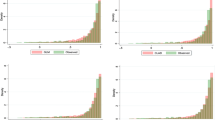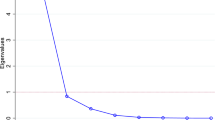Abstract
Purpose
Probabilistic mapping of the health status instrument SF-12 onto the health utility instrument EuroQol—5 dimensions (EQ-5D)-3L using the UK-population-based scoring model showed encouraging results as compared to other mapping methods, although its predictive performance using the US-population-based EQ-5D scoring models has not been investigated. In addition, a new and improved US-population-based EQ-5D scoring method has recently been developed and suggested for use in applications that required US societal health state values. In this study, we assessed predictive performance of the probabilistic mapping approach using the US-population-based scoring models on EQ-5D utility scores based on SF-12 responses and compared the results with those of other mapping methods.
Methods
Using a sample of 19,678 adults from the 2003 Medical Expenditure Panel Survey, we evaluated the predictive performance of probabilistic mapping using Bayesian networks, response mapping using multinomial logistic regression, ordinary least squares, and censored least absolute deviations models by implementing a fivefold cross-validation method. The EQ-5D utility scores were generated using two US-population-based models: D1 and MM-OC.
Results
Overall, the probabilistic mapping approach using Bayesian networks consistently outperformed other mapping methods with mean squared errors (MSE) of 0.007 and 0.007, mean absolute errors (MAE) of 0.057 and 0.039, and overall R 2 of 0.773 and 0.770 for the US-population-based EQ-5D scoring D1 and MM-OC models, respectively.
Conclusion
The probabilistic mapping approach can be useful to estimate EQ-5D utility scores from SF-12 responses with better predictive measures in terms of MSE, MAE, and R 2 than other common mapping methods.
Similar content being viewed by others
References
Mortimer, D., & Segal, L. (2008). Comparing the Incomparable? A systematic review of competing techniques for converting descriptive measures of health status into QALY-weights. Medical Decision Making, 28, 66–89.
Brazier, J. E., Yang, Y., Tsuchiya, A., & Rowen, D. L. (2010). A review of studies mapping (or cross walking) non-preference based measures of health to generic preference-based measures. European Journal of Health Economics, 11, 215–225.
Le, Q. A., & Doctor, J. N. (2011). Probabilistic mapping of descriptive health status responses onto health state utilities using Bayesian networks: An empirical analysis converting SF-12 into EQ-5D utility index in a national US sample. Medical Care, 49(5), 451–460.
Shaw, J. W., Johnson, J. A., & Coons, S. J. (2005). US valuation of the EQ-5D health states: Development and testing of the D1 valuation model. Medical Care, 43, 203–220.
Shaw, J. W., Pickard, A. S., Yu, S., Chen, S., Iannacchione, V. G., Johnson, J. A., et al. (2010). A median model for predicting United States population-based EQ-5D health state preferences. Value in Health, 13(2), 278–288.
Kind, P. (2003). Guidelines for value sets in economic and on-economic studies using EQ-5D. In R. Brooks, R. Rabin, & F. D. Charro (Eds.), The measurement and valuation of health status using EQ-5D: A European perspective (pp. 29–42). Amsterdam, The Netherlands: Kluwer.
Ware, J. E., Kosinski, M., & Keller, S. D. (1996). A 12-item Short Form Health Survey: Construction of scales and preliminary tests of reliability and validity. Medical Care, 34, 220–233.
Koller, D., & Friedman, N. (2009). Probabilistic graphical models: Principles and techniques. Cambridge, MA: The MIT Press.
Jensen, F. V. (1996). An introduction to Bayesian networks. New York: Springer.
Pearl, J. (2009). Causality: Models, reasoning, and inference. New York, NY: Cambridge University Press.
Neapolitan, R. E. (2003). Learning Bayesian networks. Upper Saddle River, NJ: Prentice-Hall.
Hugin Expert A/S. (2011). Hugin researcher: Release 7.6. Aalborg, Denmark: Hugin Expert A/S.
Madsen, A. L., Lang, M., Kjærulff, U. B., & Jensen, F. (2003). The Hugin tool for learning Bayesian networks. Lecture Notes in Computer Science, 2711, 594–605.
Gray, A., Rivero-Arias, O., & Clarke, P. (2006). Estimating the association between SF-12 responses and EQ-5D utility values by response mapping. Medical Decision Making, 26, 18–29.
Franks, P., Lubetkin, D. I., Gold, M. R., & Tancredi, D. J. (2003). Mapping the SF-12 to preference-based instruments: Convergent validity in low-income, minority population. Medical Care, 41(11), 1277–1283.
Franks, P., Lubetkin, D. I., Gold, M. R., Tancredi, D. J., & Jia, H. (2004). Mapping the SF-12 to the EuroQoL EQ-5D index in a national US sample. Medical Decision Making, 24(3), 247–254.
Sullivan, P. W., & Ghushchyan, V. (2006). Mapping the EQ-5D index from the SD-12: US general population preferences in a nationally representative sample. Medical Decision Making, 26, 401–409.
Tourassi, G. D., & Floyd, C. E. (1997). The effects of data sampling on the performance evaluation of artificial neural networks in medical diagnosis. Medical Decision Making, 17, 186–192.
Vickers, A. J., Cronin, A. M., Elkin, E. B., & Gonen, M. (2008). Extensions to decision curve analysis, a novel method for evaluating diagnostic tests, prediction models and molecular markers. BMC Medical Informatics and Decision Making, 8, 53.
StataCorp. (2012). Stata statistical software: Release 12.1. College Station, TX: StataCorp LP.
Heckerman, D. (1999). A tutorial on learning with Bayesian networks. In M. I. Jordan (Ed.), Learning in graphical models. Cambridge, MA: MIT Press.
Borchani, H., Bielza, C., Martinez-Martin, P., & Larranage, P. (2012). Markov blanket-based approach for learning multi-dimensional Bayesian network classifiers: An application to predict the European Quality of Life-5 dimensions (EQ-5D) from the 39-item Parkinson’s Disease Questionnaire (PDQ-39). Journal of Biomedical Informatics, 45, 1175–1184.
Chen, S., & Khan, S. (2000). Estimating censored regression models in the presence of nonparametric multiplicative heteroskedasticity. Journal of Econometrics, 98(2), 283–316.
Huang, I. C., Frangakis, C., Atkinson, M. J., et al. (2008). Addressing ceiling effects in health status measures: A comparison of techniques applied to measures for people with HIV disease. Health Services Research, 43, 327–339.
Cheung, Y. B., Tan, L. C., Lau, P. N., et al. (2008). Mapping the eight-item Parkinson’s Disease Questionnaire (PDQ-8) to the EQ-5D utility index. Quality of Life Research, 17, 1173–1181.
Askew, R. L., Swartz, R. J., Xing, Y., et al. (2011). Mapping FACT-melanoma quality-of-life scores to EQ-5D health utility weights. Value in Health, 14, 900–9006.
Ghatnekar, O., Eriksson, M., & Glader, E. (2013). Mapping health outcome measures from a stroke registry to EQ-5D weights. Health and Quality of Life Outcomes, 11, 34.
Author information
Authors and Affiliations
Corresponding author
Electronic supplementary material
Below is the link to the electronic supplementary material.
Rights and permissions
About this article
Cite this article
Le, Q.A. Probabilistic mapping of the health status measure SF-12 onto the health utility measure EQ-5D using the US-population-based scoring models. Qual Life Res 23, 459–466 (2014). https://doi.org/10.1007/s11136-013-0517-3
Accepted:
Published:
Issue Date:
DOI: https://doi.org/10.1007/s11136-013-0517-3




